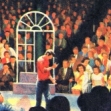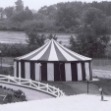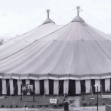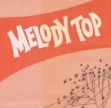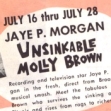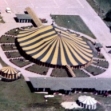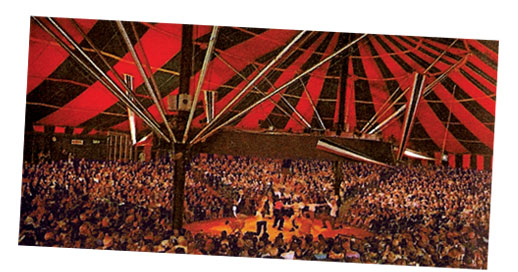
Celebrating the Fiftieth Anniversary of Melody Top's Very First Production: June 18, 1963 to June 18, 2013
In the Friday, May 10, 1963 edition of the Milwaukee Sentinel, Buck Herzog included the following piece about a brand-new theatre in his column. For those who only remember the successful years at Melody Top, it is hard to believe its start was met with a mixture of apprehension and hesitation:
Bill Rach, producer of the new Melody Top Theatre, which opens June 18 with Gordon and Sheila MacRae in GUYS AND DOLLS, was like a man haunted when he first opened his office here a couple of months ago.
Everywhere he went, people kept telling him about the abortive attempt at a tent theatre on Port Washington Road seven years ago. (Webmaster's note: During the summer of 1956, Melody Circus Theatre near Grafton closed before completing its inaugural season.) With obvious relish, his tormentors would recall ladies decked out in their finest, plowing through oozing fields of mud, getting their shoes nicked on rocks and caked with soggy, red clay.
He would hear about the orchestra pit that was so flooded that one punster suggested gondolas for the musicians. He would hear about rain that would seep through the seams of the tent and of the wind that finally carried the poor thing (the tent) away.
So Bill went to work to keep the weather out of his tent. The Melody Top is rainproof, windproof and fireproof. And about the mud? Everything is paved. The huge parking lot is paved and lighted and all entrances to the theatre will be paved.
But about the gondolas? Bill has put a pump in the orchestra pit – just in case some little rain drops should somehow escape the many weather protection devices.
Advance ticket sales for Melody Top Theatre had just passed the $65,000 mark.
Melody Top Theatre: More Than Just a Summer Tent
(Taken from the 1963 souvenir program of GUYS AND DOLLS.)
Not too many years ago, anyone with a large tent, some folding chairs and a box office could establish himself in the summer theatre business almost overnight. Not so in this present day and age. It is a far more complex thing to operate a summer theatre today.
In the summer of 1960, the first Melody Top Theatre was opened in Hillside, Illinois, just outside of Chicago. Now, a mere three seasons later, the second Melody Top venture is launched with a promising career in Milwaukee, Wisconsin.
The music tent is a unique institution, quite different than any other. Unlike the circus tent, which is temporarily anchored on a plot of flat, unprepared land, and then taken down and folded like an Arab's tent to disappear into the night, the Melody Top tents are actually "constructed," permanent installations. Steam shovels, bulldozers, men with their picks and shovels, worked for months hollowing a huge bowl from the acres and acres of open land required for this kind of operation. This bowl is then terraced and covered with a special material and a concrete stage is placed in the center. Without the canvas covering, there is a huge arena-type amphitheatre.
The canvas and the entire overhead structure consisting of one hundred and twenty lights, a $10,000 stereophonic sound system, scenery, etc. are hung from a massive, two thousand pound gridiron. This in turn is held in place by two fifty-four foot, three-and-a-half ton steel main masts. These masts are supported by two thousand feet of cable anchored onto ten weighty "deadmen." The "deadmen" are giant slabs of concrete – 108 cubic feet of it for each – reinforced with steel which has been sunk ten feet under the ground. A spreading, umbrella-type arrangement on each mast, along with the gridiron, holds the entire overhead structure. The Melody Tops are stormproof and fireproof. It would take a one-hundred-and-ten-mile per hour wind to even tear the canvas, let alone blow it away. The tent has been completely safety engineered by the designing architects of the Sheraton and Conrad Hilton Hotels in Chicago. The permanency of the two theatres is not only in the ten tons of steel and 1,080 cubic yards of concrete, but also in the long leases on the land on which they are situated.
Although the theatres are tents, each theatre is supported by $75,000 in buildings of brick and mortar, housing rehearsal halls and shops, refreshment stands and box offices. Each plant represents an investment of over $200,000.
Delightful breezes keep the theatres cool and comfortable, even on the hottest nights. There is an intimacy in theatre-in-the-round that cannot be duplicated. The audience feels itself, in effect, part of the closeness of the spectators to the musical and dramatic action. The balance between detachment and participation is absolute; the root idea of theatre is miraculously achieved.
The idea for the modern concept in musical comedy tents came from a hole in the ground dug in Luzon in 1944. It was the brainstorm of one St. John (rhymes with Injun) Terrell, a grounded transport pilot who managed USO troupes in the Army throughout the South Pacific. The hole was Terrell's solution to the problem presented by the arrival of Irving Berlin’s show THIS IS THE ARMY in Manila, and the subsequent discovery that there was not a theatre big enough to hold it. "Get out the bulldozers, dig a saucer in the ground and put a tent over it," suggested the former pilot. The Army replied with a deafening "No!," but the germ for what was to become an adjunct to "straw hat theatre" or "summer stock" was planted in the fertile Terrell brain: the first musical comedy tent theatre. Terrell's, of course, opened in Lambertville, New Jersey in 1949. Eight weeks before, however, the producer of the then slightly off-beat venture found out that his backers, representing $50,000 in pledges, had walked out on him. However, with the aid of his indomitable determination, Swiss bell ringers, fireworks, celebrities and searchlights, he opened his Lambertville Music Circus on a hill top, July 2, 1949, with THE MERRY WIDOW.
The people were charmed. They bought their tickets in circus wagons, watched a fine musical production in a rare setting: in a tent and in the round. To Broadway's surprise, he cleared $20,000 the first year. Ten years later, he could look forward to a gross of $900,000, a net profit for him of $100,000. He eventually had a string of four tents.
Skeptics persisted, stating that the novelty and flamboyant hoopla would wear off, but the candy striped musical big top is now a magnificent segment of a multimillion dollar summer show business dispersed throughout the entire country. While Broadway keeps shrinking, tent musicals keep expanding. Today there are 27 tune-tents. Theatrical scholars point out it is the only form of theatre showing constant growth. In its first ten years, musical tents played to 13 million Americans to the tune of $25 million dollars, proving unmistakably the lure of musicals under the big top.
The Melody Top Theatres result from years of planning, extensive travel and exhaustive research and experience by the hosts, Messrs. Bill Rach, Charles Comiskey and Joseph Vaughn. The Chicago and Milwaukee tents make Melody Top the largest summer theatre chain in the Midwest, and plans are underway for theatres in two other cities to be opened within the next two years.
The History of Melody Top Theatre
(Taken from the 21st season souvenir program, with edits and updates by the webmaster.)
The corner of 76th Street and Good Hope Road in Milwaukee was only meadowland in the late 1950s, but in 1962 a group of Chicago businessmen petitioned the Common Council for permission to build a tent theatre on this location and soon after Melody Top Theatre was born. When the original inventors went bankrupt in 1965, William Luff, owner of the Good Hope Road property, bought the theatre and together with a group of local business men, opened the 1966 season with THE KING AND I. In 1978, a permanent wooden dome was constructed, but the recognizable atmosphere of the tent was retained by keeping the canvas sidewalls and surrounding concession tents.
Bill Rach, Charles Comiskey and Joseph Vaughn produced Melody Top's first three seasons. When William Luff's organization took over the operation in 1966, Elmer Regner was employed as executive producer for the next five seasons. After serving as general manager during 1969 and 1970, Martin Wiviott was engaged as producer from 1971 through 1978, when the permanent wooden dome was erected. After the 16th season, Wiviott departed Wisconsin for California and is currently, in 2013, general manager of Broadway/L.A. and the Pantages Theatre. In January of 1979, Guy S. Little, Jr. was engaged as producer-general manager and remained through the 1985 season. The last season, in 1986, was assembled by Tom Marks (artistic director), Michael Wilson (associate producer) and Philip Proctor (producer-general manager).
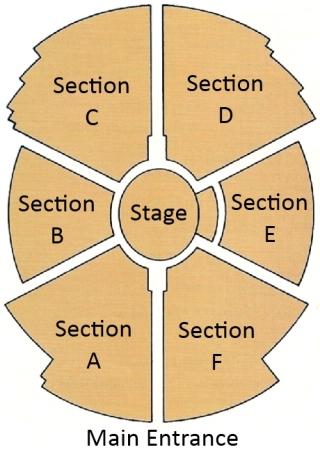
After analyzing over 4,000 ballots from audience members, the new producers announced an intriguing 1987 season of eight shows: HELLO, DOLLY!, THE PIRATES OF PENZANCE, THE KING AND I, BABY, THE MUSIC MAN, SUGAR BABIES, BRIGADOON and what would have been the theatre's first opera, CARMEN. In October of 1986, the board of directors announced the closing of Melody Top Theatre. This sad announcement made front-page news in the daily newspapers. Poor box office figures from the truncated 1986 season (which featured talented performers from Milwaukee and Chicago, rather than well-known headliners) were cited as the main reason. Many believe the passing of William Luff, "Melody Top’s best friend," on July 9, 1984, was the beginning of the end for this beloved institution. A loving and honorable tribute to Mr. Luff was published in programs for the rest of the season.
Changing tastes in live theatre probably contributed to closing the financially troubled Melody Top. Most theatregoers at the time were interested in seeing extravagant spectacles from London's West End as opposed to classic shows from Broadway's Golden Age. The performing rights to hit musicals from New York were harder to obtain because productions toured the country for longer periods of time in the 1970s and 1980s. Competition from the growing downtown theatre scene was very strong.
On the afternoon of Thursday, September 19, 1991, a two-alarm fire gutted the theatre building. Brothers Dale and Glen Poniewaz hoped to open an ambitious $12-15 million entertainment complex on the grounds, called Melody Gardens, but these plans never materialized. Melody Top Theatre, like so many similar venues, was finished.
Melody Top’s old parking lot is still used by patrons of Uihlein Soccer Park, located next door to the theatre's former grounds. All of the Melody Top buildings have been razed, and a metal fence prohibits entrance. The site is, once again, partially a meadowland.
The graphic on this page is of the seating plan at Melody Top Theatre. According to Tim Kraetsch, the final count of seats in the auditorium was 2,156. The theatre had a capacity of entertaining approximately 241,472 patrons each summer (8 shows a week x 14 weeks a year x 2,156 seats = 241,472 patrons). The orchestra pit is located to the right (west) of the stage in front of section E.
Below are two tables based on information gathered from Melody Top's 10th anniversary (1966 to 1975) annual report. The tables were sorted by both ticket sales and attendance, ranking shows from 1 to 70 (10 seasons at 7 productions per season). Three disclaimers must be applied to these figures. One: Because Melody Top was originally opened and managed by a Chicago corporation, figures for the first three seasons (1963 to 1965) are not available. Two: Seating capacity and ticket prices often changed from year to year. During the 1966 season, ticket prices were listed in three ranges: 4.10, 3.10 and 2.10 with Saturday evening performances at 4.65, 3.65 and 2.65. For the summer of 1975, ticket prices increased to 5.75, 4.75 and 3.75 with Saturday evenings at 6.50, 5.50 and 4.50. Three: The 1975 production of CAMELOT, starring Ed Ames and Linda Michele, added two additional performances, Saturdays at 4:00, which explains why both sales and attendance far surpass any prior production.
Melody Top Productions Ranked by Sales, 1966 – 1975
| Rank | Production Title | Year | Sales |
| 1. | CAMELOT | 1975 | $164,859 |
| 2. | THE UNSINKABLE MOLLY BROWN | 1975 | $138,485 |
| 3. | ANNIE GET YOUR GUN | 1975 | $130,457 |
| 4. | GYPSY | 1975 | $128,348 |
| 5. | THE KING & I | 1974 | $126,819 |
| 6. | SUGAR | 1974 | $125,704 |
| 7. | GUYS AND DOLLS | 1974 | $125,368 |
| 8. | FINIAN'S RAINBOW | 1974 | $121,992 |
| 9. | GIGI | 1974 | $119,468 |
| 10. | ONCE UPON A MATTRESS | 1974 | $119,419 |
| 11. | THE MUSIC MAN | 1973 | $116,789 |
| 12. | PROMISES, PROMISES | 1973 | $115,464 |
| 13. | BRIGADOON | 1973 | $114,813 |
| 14. | SOUTH PACIFIC | 1973 | $111,560 |
| 15. | GOOD NEWS | 1975 | $111,393 |
| 16. | BITTER SWEET | 1975 | $109,925 |
| 17. | MAN OF LA MANCHA | 1972 | $105,913 |
| 18. | OLIVER! | 1972 | $104,082 |
| 19. | ZORBA | 1975 | $103,601 |
| 20. | FIDDLER ON THE ROOF | 1971 | $103,413 |
| 21. | MEET ME IN ST. LOUIS | 1971 | $102,908 |
| 22. | THE SOUND OF MUSIC | 1972 | $102,430 |
| 23. | SHOW BOAT | 1970 | $100,835 |
| 24. | LITTLE ME | 1972 | $100,165 |
| 25. | 1776 | 1972 | $98,826 |
| 26. | COMPANY | 1972 | $98,567 |
| 27. | KISS ME, KATE | 1972 | $98,430 |
| 28. | APPLAUSE | 1973 | $97,592 |
| 29. | NO, NO, NANETTE | 1974 | $96,621 |
| 30. | WEST SIDE STORY | 1973 | $96,110 |
| 31. | FUNNY GIRL | 1970 | $94,820 |
| 32. | KISMET | 1971 | $92,396 |
| 33. | OKLAHOMA | 1969 | $86,763 |
| 34. | ON A CLEAR DAY… | 1967 | $85,162 |
| 35. | HELLO, DOLLY! | 1971 | $84,521 |
| 36. | GEORGE M! | 1971 | $83,788 |
| 37. | MAME | 1970 | $81,904 |
| 38. | THE ROAR OF THE GREASEPAINT… | 1969 | $81,483 |
| 39. | PLAIN AND FANCY | 1971 | $80,331 |
| 40. | I DO! I DO! | 1970 | $79,585 |
| 41. | DAMN YANKEES | 1971 | $79,242 |
| 42. | WONDERFUL TOWN | 1973 | $78,077 |
| 43. | CAROUSEL | 1967 | $76,307 |
| 44. | PAINT YOUR WAGON | 1969 | $74,562 |
| 45. | FANNY | 1968 | $73,776 |
| 46. | HOW TO SUCCEED… | 1966 | $72,270 |
| 47. | SILK STOCKINGS | 1967 | $66,592 |
| 48. | THE DESERT SONG | 1968 | $66,198 |
| 49. | CABARET | 1970 | $65,914 |
| 50. | THE BOY FRIEND | 1967 | $63,939 |
| 51. | SONG OF NORWAY | 1969 | $60,984 |
| 52. | HIGH BUTTON SHOES | 1967 | $60,948 |
| 53. | ANYTHING GOES | 1969 | $60,357 |
| 54. | THE MOST HAPPY FELLA | 1969 | $59,253 |
| 55. | GYPSY | 1966 | $58,910 |
| 56. | LI'L ABNER | 1970 | $58,436 |
| 57. | HOW NOW, DOW JONES | 1970 | $58,029 |
| 58. | THE KING & I | 1966 | $56,653 |
| 59. | PAL JOEY | 1968 | $55,439 |
| 60. | IRMA LA DOUCE | 1968 | $52,646 |
| 61. | FLOWER DRUM SONG | 1966 | $52,625 |
| 62. | CALL ME MADAM | 1966 | $50,826 |
| 63. | TAKE ME ALONG | 1968 | $49,073 |
| 64. | SWEET CHARITY | 1967 | $48,676 |
| 65. | CAN-CAN | 1966 | $48,594 |
| 66. | WHERE'S CHARLEY? | 1968 | $48,198 |
| 67. | CARNIVAL | 1969 | $47,923 |
| 68. | OF THEE I SING | 1968 | $45,403 |
| 69. | LADY IN THE DARK | 1967 | $42,018 |
| 70. | MILK AND HONEY | 1966 | $41,920 |
Melody Top Productions Ranked by Attendance, 1966 – 1975
| Rank | Production Title | Year | Attendance |
| 1. | CAMELOT | 1975 | 34,088 |
| 2. | THE KING & I | 1974 | 28,839 |
| 3. | SUGAR | 1974 | 28,644 |
| 4. | THE MUSIC MAN | 1973 | 28,617 |
| 5. | GUYS AND DOLLS | 1974 | 28,568 |
| 6. | THE UNSINKABLE MOLLY BROWN | 1975 | 28,451 |
| 7. | PROMISES, PROMISES | 1973 | 28,160 |
| 8. | BRIGADOON | 1973 | 27,958 |
| 9. | MAN OF LA MANCHA | 1972 | 27,822 |
| 10. | FINIAN'S RAINBOW | 1974 | 27,686 |
| 11. | FIDDLER ON THE ROOF | 1971 | 27,506 |
| 12. | OLIVER! | 1972 | 27,209 |
| 13. | MEET ME IN ST. LOUIS | 1971 | 27,191 |
| 14. | SOUTH PACIFIC | 1973 | 27,135 |
| 15. | GIGI | 1974 | 27,039 |
| 16. | THE SOUND OF MUSIC | 1972 | 27,000 |
| 17. | ONCE UPON A MATTRESS | 1974 | 26,878 |
| 18. | ANNIE GET YOUR GUN | 1975 | 26,496 |
| 19. | SHOW BOAT | 1970 | 26,436 |
| 20. | GYPSY | 1975 | 25,945 |
| 21. | LITTLE ME | 1972 | 25,828 |
| 22. | 1776 | 1972 | 25,728 |
| 23. | KISS ME, KATE | 1972 | 25,523 |
| 24. | COMPANY | 1972 | 25,382 |
| 25. | OKLAHOMA | 1969 | 25,015 |
| 26. | FUNNY GIRL | 1970 | 24,781 |
| 27. | ON A CLEAR DAY… | 1967 | 24,611 |
| 28. | KISMET | 1971 | 23,757 |
| 29. | APPLAUSE | 1973 | 23,005 |
| 30. | WEST SIDE STORY | 1973 | 22,732 |
| 31. | THE ROAR OF THE GREASEPAINT… | 1969 | 22,702 |
| 32. | HOW TO SUCCEED… | 1966 | 22,183 |
| 33. | GOOD NEWS | 1975 | 22,175 |
| 34. | BITTER SWEET | 1975 | 21,873 |
| 35. | HELLO, DOLLY! | 1971 | 21,628 |
| 36. | CAROUSEL | 1967 | 21,480 |
| 37. | GEORGE M! | 1971 | 21,263 |
| 38. | NO, NO, NANETTE | 1974 | 21,156 |
| 39. | MAME | 1970 | 20,838 |
| 40. | PAINT YOUR WAGON | 1969 | 20,742 |
| 41. | FANNY | 1968 | 20,620 |
| 42. | ZORBA | 1975 | 20,491 |
| 43. | PLAIN AND FANCY | 1971 | 20,357 |
| 44. | DAMN YANKEES | 1971 | 20,162 |
| 45. | I DO! I DO! | 1970 | 20,082 |
| 46. | THE DESERT SONG | 1968 | 18,472 |
| 47. | SILK STOCKINGS | 1967 | 18,391 |
| 48. | WONDERFUL TOWN | 1973 | 18,112 |
| 49. | ANYTHING GOES | 1969 | 17,754 |
| 50. | THE BOY FRIEND | 1967 | 17,670 |
| 51. | GYPSY | 1966 | 17,600 |
| 52. | THE KING & I | 1966 | 17,356 |
| 53. | SONG OF NORWAY | 1969 | 16,920 |
| 54. | HIGH BUTTON SHOES | 1967 | 16,755 |
| 55. | CABARET | 1970 | 16,439 |
| 56. | THE MOST HAPPY FELLA | 1969 | 16,375 |
| 57. | FLOWER DRUM SONG | 1966 | 16,320 |
| 58. | PAL JOEY | 1968 | 16,191 |
| 59. | CALL ME MADAM | 1966 | 15,953 |
| 60. | HOW NOW, DOW JONES | 1970 | 14,812 |
| 61. | LI'L ABNER | 1970 | 14,772 |
| 62. | CAN-CAN | 1966 | 14,299 |
| 63. | IRMA LA DOUCE | 1968 | 14,132 |
| 64. | TAKE ME ALONG | 1968 | 13,507 |
| 65. | SWEET CHARITY | 1967 | 13,293 |
| 66. | WHERE'S CHARLEY? | 1968 | 13,124 |
| 67. | CARNIVAL | 1969 | 13,078 |
| 68. | MILK AND HONEY | 1966 | 13,022 |
| 69. | OF THEE I SING | 1968 | 12,259 |
| 70. | LADY IN THE DARK | 1967 | 11,403 |
